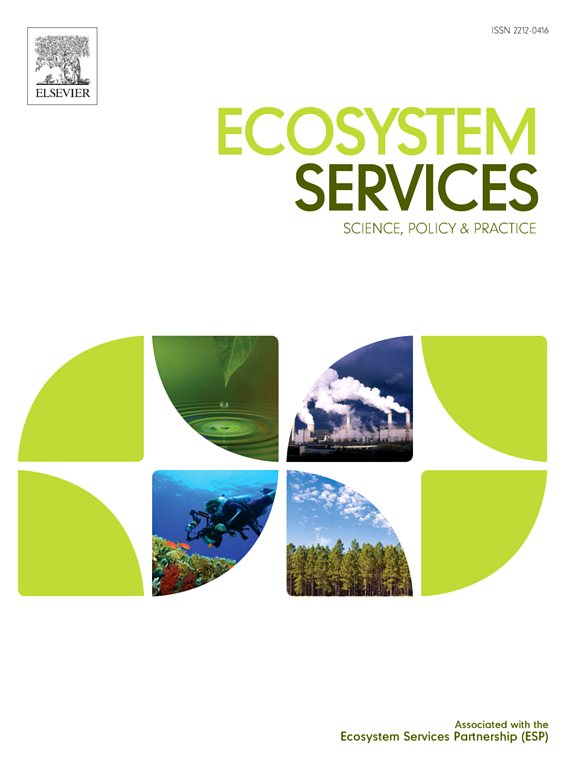Examining innovative designs of agri-environmental schemes in Europe: A case comparison of impact pathways
IF 6.6
2区 环境科学与生态学
Q1 ECOLOGY
引用次数: 0
Abstract
Agri-environmental schemes (AES), a subtype of payments for ecosystem services (PES), aim to address Europe’s environmental and climate objectives by incentivising farmers to maintain or shift to farming practices that deliver additional ecosystem services (ES). We develop a theory of change (ToC) for AES, reviewing nine European case studies at different implementation stages, yet all featuring innovative contract solutions to increase ES provision (e.g., water quality, pollination) and enhance bird and grassland biodiversity. Mirroring ecosystem and geographic variety across Europe, we analyse observed strengths and weaknesses in designing, implementing, and evaluating AES, and flag emerging research gaps. Using the comparative case study (CCS) method to analyse case-specific secondary data, we highlight the importance of local contextualization and management customization across landscapes, differentiating contract types to target variable farmer groups. Some regionally implemented schemes outside the EU’s Common Agricultural Policy (CAP) framework emphasize trust-building and prove well-tailored to local conditions. New result-based schemes may achieve both farmer uptake and incremental ES delivery, depending on ES types and costs. Spatial coordination incentives (agglomeration bonuses and thresholds) stimulate farmer uptake, but their cost effectiveness remains undocumented. Collective AES schemes can work well when collaborative traditions and accumulated social capital are ex-ante present. Mixing incentive policies with regulatory threat may boost AES uptake. Generally, high opportunity costs among intensively producing farms and complex administrative processes constitute key obstacles hampering AES success. Current research mostly measures AES success in terms of farmer participation (ToC outputs), while rigorous environmental impact evaluations (ToC outcomes and impacts) are essentially lacking. Addressing the identified obstacles and research gaps might enhance AES effectiveness, but also provides more educated perspectives on realistic potentials for AES to support European sustainability goals.
考察欧洲农业环境方案的创新设计:影响途径的案例比较
农业环境计划(AES)是生态系统服务支付(PES)的一个子类型,旨在通过激励农民保持或转向提供额外生态系统服务(ES)的耕作方式,实现欧洲的环境和气候目标。我们为AES开发了一个变化理论(ToC),回顾了9个处于不同实施阶段的欧洲案例研究,但所有案例都具有创新的合同解决方案,以增加ES供应(例如,水质,授粉)并增强鸟类和草地的生物多样性。我们反映了整个欧洲的生态系统和地理多样性,分析了在设计、实施和评估AES方面观察到的优势和劣势,并指出了新兴的研究差距。利用比较案例研究(CCS)方法分析个案特定的次要数据,我们强调了跨景观的地方情境化和管理定制的重要性,区分合同类型以针对可变的农民群体。一些在欧盟共同农业政策(CAP)框架之外的地区实施的计划强调建立信任,并被证明是适合当地情况的。新的以结果为基础的方案可能既实现农民的吸收,又实现增量的生态系统交付,具体取决于生态系统的类型和成本。空间协调激励(集聚奖金和阈值)刺激农民吸收,但其成本效益仍未得到证实。当协作传统和积累的社会资本事先存在时,集体AES方案可以很好地发挥作用。将激励政策与监管威胁相结合,可能会促进AES的采用。一般来说,集约化生产农场的高机会成本和复杂的管理程序是阻碍农业生产成功的主要障碍。目前的研究主要是根据农民参与(ToC产出)来衡量农业生态系统的成功,而严格的环境影响评估(ToC成果和影响)基本上是缺乏的。解决已确定的障碍和研究差距可能会提高AES的有效性,但也为AES支持欧洲可持续发展目标的现实潜力提供了更有教育意义的视角。
本文章由计算机程序翻译,如有差异,请以英文原文为准。
求助全文
约1分钟内获得全文
求助全文
来源期刊

Ecosystem Services
ECOLOGYENVIRONMENTAL SCIENCES&-ENVIRONMENTAL SCIENCES
CiteScore
14.90
自引率
7.90%
发文量
109
期刊介绍:
Ecosystem Services is an international, interdisciplinary journal that is associated with the Ecosystem Services Partnership (ESP). The journal is dedicated to exploring the science, policy, and practice related to ecosystem services, which are the various ways in which ecosystems contribute to human well-being, both directly and indirectly.
Ecosystem Services contributes to the broader goal of ensuring that the benefits of ecosystems are recognized, valued, and sustainably managed for the well-being of current and future generations. The journal serves as a platform for scholars, practitioners, policymakers, and other stakeholders to share their findings and insights, fostering collaboration and innovation in the field of ecosystem services.
 求助内容:
求助内容: 应助结果提醒方式:
应助结果提醒方式:


